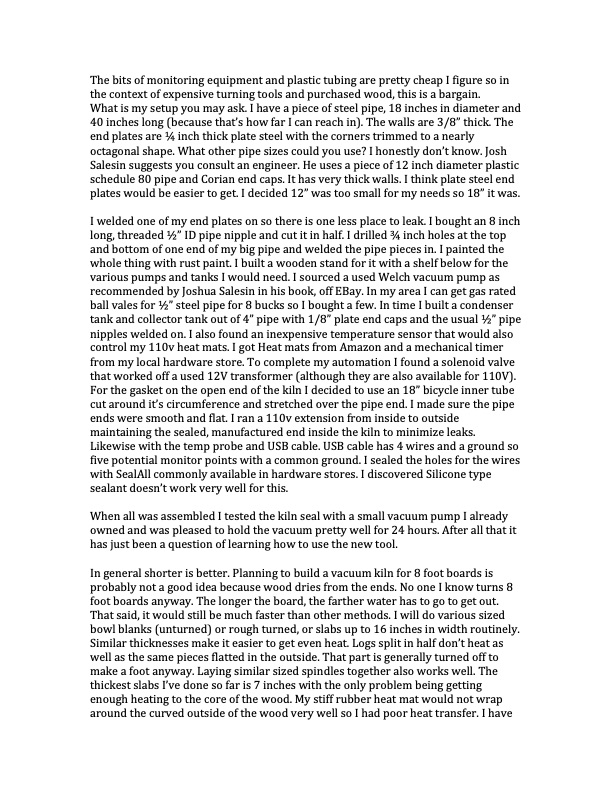
PDF Publication Title:
Text from PDF Page: 003
The bits of monitoring equipment and plastic tubing are pretty cheap I figure so in the context of expensive turning tools and purchased wood, this is a bargain. What is my setup you may ask. I have a piece of steel pipe, 18 inches in diameter and 40 inches long (because that’s how far I can reach in). The walls are 3/8” thick. The end plates are 1⁄4 inch thick plate steel with the corners trimmed to a nearly octagonal shape. What other pipe sizes could you use? I honestly don’t know. Josh Salesin suggests you consult an engineer. He uses a piece of 12 inch diameter plastic schedule 80 pipe and Corian end caps. It has very thick walls. I think plate steel end plates would be easier to get. I decided 12” was too small for my needs so 18” it was. I welded one of my end plates on so there is one less place to leak. I bought an 8 inch long, threaded 1⁄2” ID pipe nipple and cut it in half. I drilled 3⁄4 inch holes at the top and bottom of one end of my big pipe and welded the pipe pieces in. I painted the whole thing with rust paint. I built a wooden stand for it with a shelf below for the various pumps and tanks I would need. I sourced a used Welch vacuum pump as recommended by Joshua Salesin in his book, off EBay. In my area I can get gas rated ball vales for 1⁄2” steel pipe for 8 bucks so I bought a few. In time I built a condenser tank and collector tank out of 4” pipe with 1/8” plate end caps and the usual 1⁄2” pipe nipples welded on. I also found an inexpensive temperature sensor that would also control my 110v heat mats. I got Heat mats from Amazon and a mechanical timer from my local hardware store. To complete my automation I found a solenoid valve that worked off a used 12V transformer (although they are also available for 110V). For the gasket on the open end of the kiln I decided to use an 18” bicycle inner tube cut around it’s circumference and stretched over the pipe end. I made sure the pipe ends were smooth and flat. I ran a 110v extension from inside to outside maintaining the sealed, manufactured end inside the kiln to minimize leaks. Likewise with the temp probe and USB cable. USB cable has 4 wires and a ground so five potential monitor points with a common ground. I sealed the holes for the wires with SealAll commonly available in hardware stores. I discovered Silicone type sealant doesn’t work very well for this. When all was assembled I tested the kiln seal with a small vacuum pump I already owned and was pleased to hold the vacuum pretty well for 24 hours. After all that it has just been a question of learning how to use the new tool. In general shorter is better. Planning to build a vacuum kiln for 8 foot boards is probably not a good idea because wood dries from the ends. No one I know turns 8 foot boards anyway. The longer the board, the farther water has to go to get out. That said, it would still be much faster than other methods. I will do various sized bowl blanks (unturned) or rough turned, or slabs up to 16 inches in width routinely. Similar thicknesses make it easier to get even heat. Logs split in half don’t heat as well as the same pieces flatted in the outside. That part is generally turned off to make a foot anyway. Laying similar sized spindles together also works well. The thickest slabs I’ve done so far is 7 inches with the only problem being getting enough heating to the core of the wood. My stiff rubber heat mat would not wrap around the curved outside of the wood very well so I had poor heat transfer. I havePDF Image | Vacuum Kiln Wood Drying

PDF Search Title:
Vacuum Kiln Wood DryingOriginal File Name Searched:
Vacuum-Kiln-Wood-Drying-PDF.pdfDIY PDF Search: Google It | Yahoo | Bing
5,000 BF Shipping Container Lumber Dry Kiln For Quality Lumber The 5,000 BF container kiln consists of one 40 foot high-cube aluminum shipping container... More Info
Shipping Container Lumber Dry Kilns by Global Energy Global Energy designed and developed the container kiln back in 1991. The purpose is to give access to portable sawmill owners, furniture makers, and small business the value added profit of dry kiln lumber and quality hardwoods... More Info
Vacuum Kiln Conversion Kit for Lumber and Wood Dry Kilns Convert your existing conventional dry kiln into a fast drying vacuum kiln. Similar to vacuum bagging in the boat building and aircraft industry, we have come up with a proprietary process which allows you to build a very simple vacuum kiln at a fraction of the price, and without the intensive conventional metal chamber structure... More Info
Vacuum Pump Cart System for Bagging Clamping Wood Drying and more Vacuum Cart with 2HP Pump and Dual Pistons with multiple multiplex vacuum ports and liquid reservoir... More Info
Vacuum Bagging Basics Vacuum bagging is a method of clamping, which has traditionally been used in the composites industry, but can also be used for vacuum drying materials, including wood products... More Info
| CONTACT TEL: 608-238-6001 Email: greg@globalmicroturbine.com | RSS | AMP |